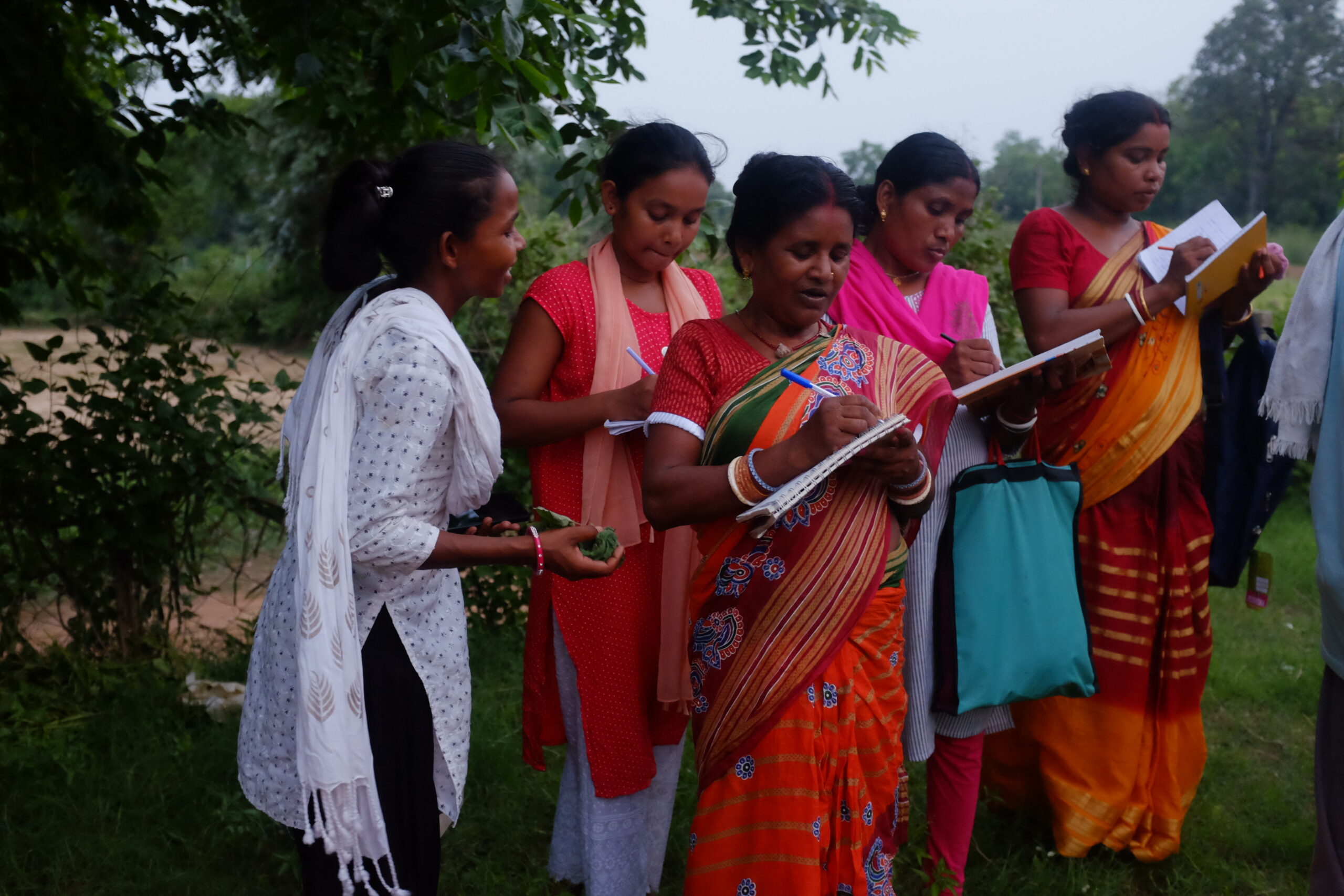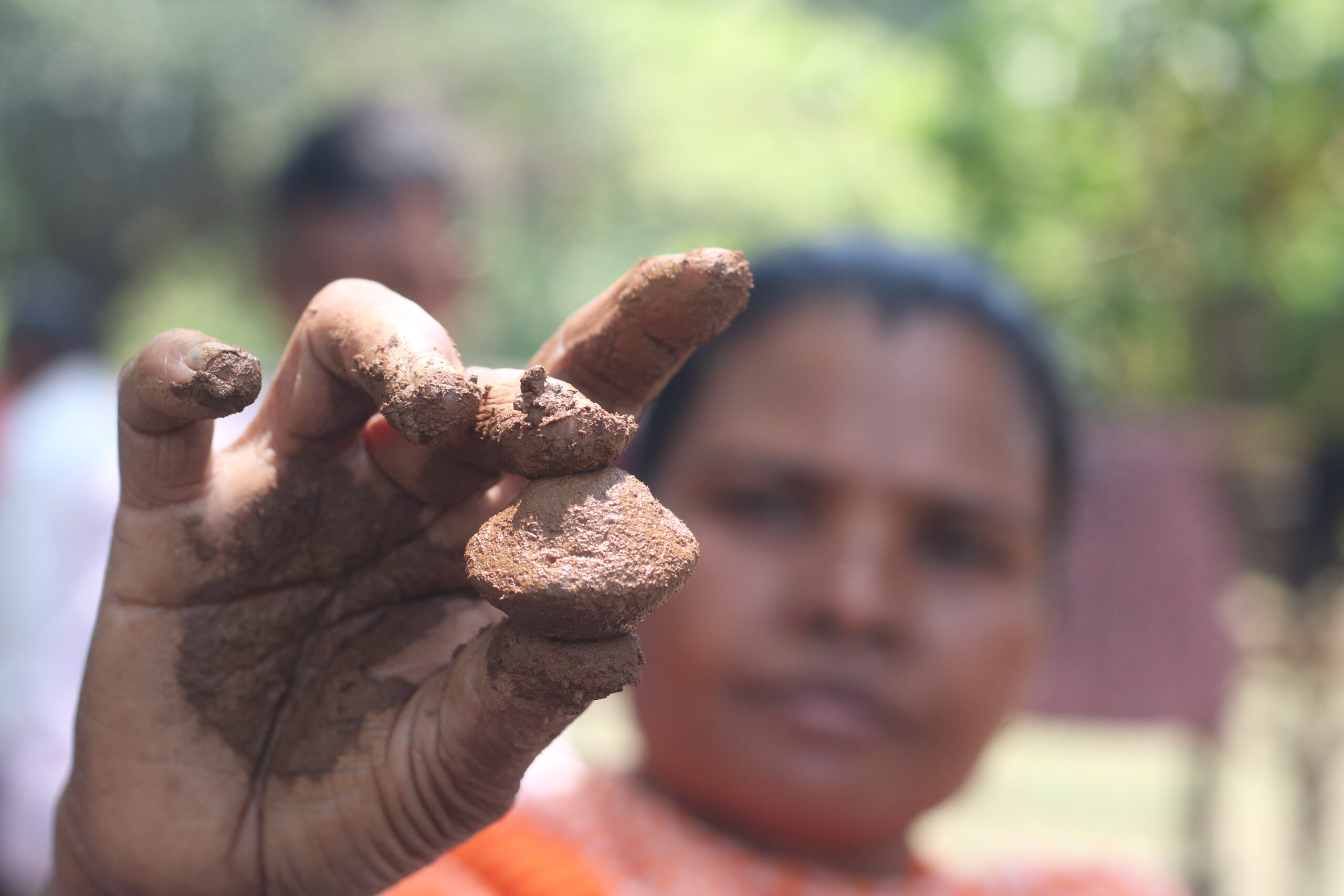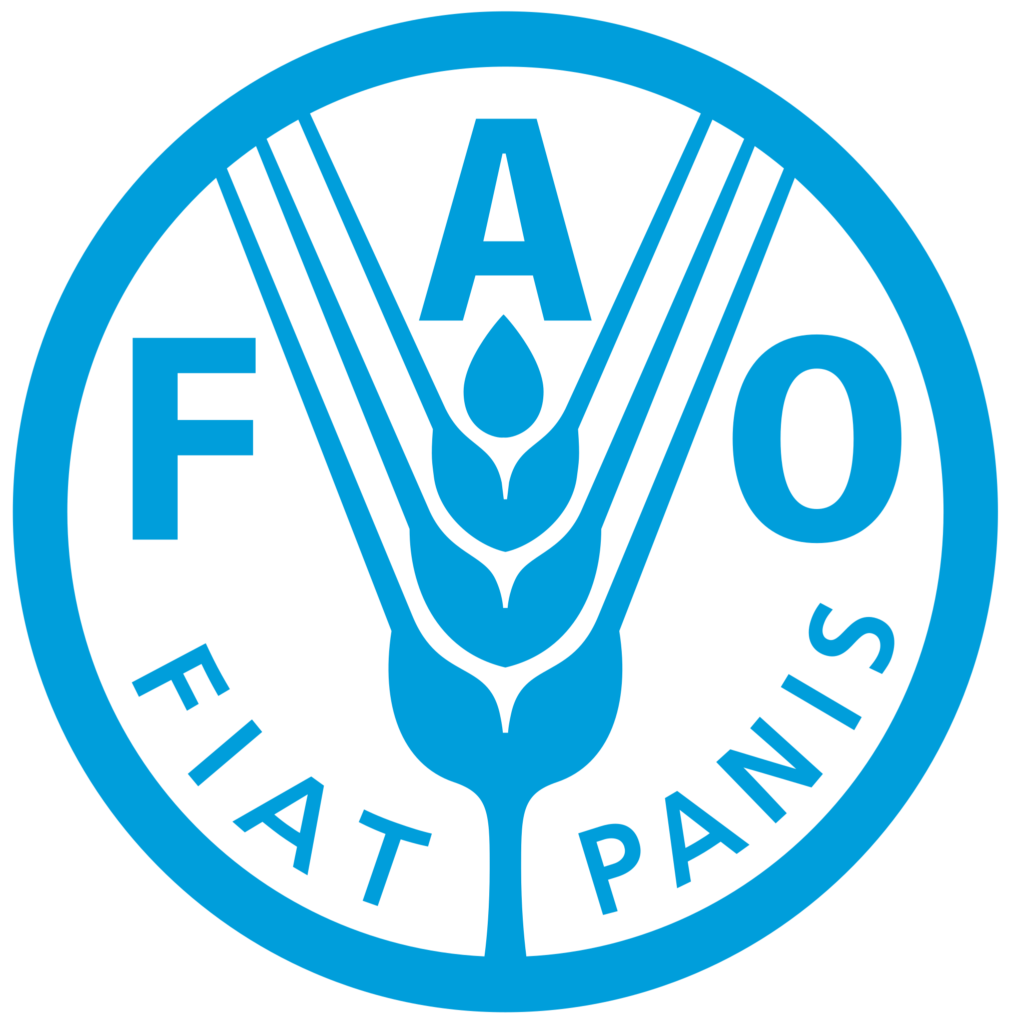By Rohan Mukerjee, Eastern India Team, Networks and Alliances Programme Coordinator
Since its inception in 2022, Keystone Foundation’s Eastern India Initiative has been steadily expanding, with projects currently being carried out across 5 districts of Jharkhand, and 2 districts each in West Bengal and Odisha. On the 10th, 11th and 12th of June the staff, partners and Community Resource Persons (CRPs) of this initiative came together at Mukundaram Community Hall, in Ichharia village, Bankura District, West Bengal. This program had multiple purposes. The first goal was to bring together all staff, partners and CRPs working on various project implementations in Eastern India to share their experiences, reflect on progress and activities carried out in the first half of 2024. We introduced new community resource persons to the rest of the team, acquainted them with the goals and objectives of the project, and facilitated planning for the upcoming months. With the agricultural season upon us, another objective was to facilitate capacity building and encourage critical thinking with regards to promoting Ecological Farming practices and Agroecology approaches. In this context, various practical and theoretical sessions were conducted. This program was attended by a total of 43 participants (16 women and 27 men) in addition to 4 resource persons. All major projects being implemented in the region were represented namely – the Using Diversity project, the Eastern India project and the PNF fellowship.
The participants arrived on 10th of June and in the early evening, after the fierce summer heat had abated, the participants gathered outside the hall for a round of introductions and sharing of experience and area updates. Our host, Bhairab Saini welcomed all the participants and provided a brief overview of the work he is engaged in. He shared that he himself is a farmer and he and his team has been working with and promoting organic agriculture and ecological farming practices for over 20 years. They have established the organization Panchal Susthaye Krishi Udyog Samiti, which promotes ecological farming, traditional seeds, and seed conservation in the region. Since 2010 he, along with Soumik Banerjee, has been focusing on seed characterisation and conservation efforts and is currently cultivating and conserving over 500 Traditional seeds of various crops like Paddy, Millets, Maize, Pulses, vegetables, oilseed and cotton.
Rohan Mukerjee (Programme Coordinator – Keystone Foundation), also welcomed the participants and provided a brief overview of Keystone Foundation and the Eastern India Initiative especially for the benefit of new participants. He highlighted that since 2022 we have been expanding our work in the region focussing on the following themes – Food Sovereignty, Agroecology and Sustainable Livelihoods; Water Security and conservation of water sources; Environmental Governance; Climate Action and Gender Justice. We seek to pursue a People Led Development (PLD) approach to our work with the communities we work with being empowered to identify the challenges they are facing and then jointly develop and implement viable solutions.
Jagabandhu Sanda (Consultant – Eastern India Project) addressed the gathering sharing his thoughts on the multitude of challenges facing the community and the environment in the areas where we work. With regards to food systems he pointed out that there has been tremendous erosion of traditional food systems across the region with traditional crops like local paddy varieties, maize, millets, pulses and vegetables being fast replaced by a narrow number of hybrid crops. While the cultivation and consumption of vital local crops like millets, which made important contributions to the health and nutrition of local communities, is declining in our villages there is an ever-increasing demand for them in cities like Jamshedpur where their health benefits have pushed up their prices. As a result of these shifts and changes rural communities are no longer able to access healthy and nutritious food and have to depend on food from markets and the Public Distribution System (PDS) which comprises crops cultivated using harmful chemical inputs. He emphasised the need to value the importance and benefits of our traditional food production systems and traditional crops and foods and work for their conservation and revival.
After this the participants from different areas shared their thoughts, experiences and updates. Surja Paharia (Field Assistant – Keystone Foundation), from Sundar Pahari, Godda District, Jharkhand, who has been working with Keystone Foundation since 2017 shared his experiences and provided updates regarding work in the last six months. He said that he and the other participants who accompanied him come from a region known as Sundar Pahari (translated to Beautiful Hills) and while there are hills where they live, they are not so Sundar / Beautiful. The people there are poor, and they face many challenges. The Paharia people still carry out Kurwa – their traditional shifting cultivation practice, in the hills of Sundar Pahari. This practice used to provide them with a diverse variety of crops that included Maize, Pulses like pigeon pea, horse gram, cow pea; millets – Sorghum, Pearl Millet, Finger millet, Foxtail millet, Little Millet and Job’s tear; and a variety of vegetables. In addition, the forests and water bodies were a source of diverse wild foods like tuber, greens, fruits, mushrooms, insects and aquatic species. However, over the years this system has been eroded and a lot of diversity has been lost. Paharia farmers had lost many millet seeds and only a handful of crops were still cultivated which negatively impacted their health and nutritional security. Surja himself did not have much knowledge about several of the traditional crops of the Paharia people before he commenced working for their revival in 2014-15. His work commenced with research regarding traditional crops and their status. Then through the Using Diversity project he works for the revival of these crops and spreads awareness about their benefits and importance and the need to resume their cultivation and consumption. They got seeds from different areas like Topra – Ranchi, Chhattisgarh and Krishi Mela in different areas like in Tamil Nadu and Odisha. Over the years traditional seeds were distributed to Paharia farmers across 30 villages and community seed banks were established. He was proud to share that a majority of the crops have returned to the farmers lands and farmers are regularly returning seeds to the seed banks so that they can be distributed to more and more farmers. He also spread awareness among children regarding the diverse variety of wild and uncultivated foods. He shared that many children did not know about many wild foods, for instance they did not know which mushrooms were to be consumed and which were toxic. Through village elder programmes he has been reviving knowledge and consumption of the different kinds of wild foods. They have also facilitated the formation of the Paharia Jungle Bachao Samiti which has been working to promote protection and conservation of forests and promoting action to prevent and mitigate forest fires. In the last six months he has been busy with coordinating return of traditional seeds by farmers to the community seeds and facilitating training and awareness programs on a variety of topics which included Kitchen Gardens, revival of Kurwa cultivation, wild food and forest conservation. He is targeting supporting establishment of at least 20 Kitchen Gardens per village and has conducted meetings and trainings to explain the importance of such nutrition gardens and the methods of establishing and managing them.
Paharia village elder and CRP Leta Paharia then shared his thoughts and experiences. He uses his knowledge of wild and uncultivated food and traditional crops to support Surja and the rest of the team in efforts to revive and promote these wild foods and crops. He also helps conduct village elder programs and coordinate cultivation drives and initiatives. Leta also works with the water team, putting bleaching powder in village wells to improve water quality and help reduce spread of waterborne diseases.
Barnabas Paharia, Using Diversity project CRP from Chamdade village, Sundar Pahari, joined the project in January 2024 and has been working alongside Surja and the rest of the Sundar Pahari team to promote Ecological Farming practices, revival of traditional food systems revolving around Kurwa cultivation. Along with Surja he has been reaching out to and identifying farmers who want to cultivate traditional crops on their lands, facilitating distribution of traditional seeds among these farmers, and also working with them to ensure effective land preparation and spreading awareness about other ecological farming practices. He shared that his work has highlighted the fact that the traditional staples of the Paharia like Gangi Jaggu (Maize Gruel or Porridge like preparation) and Tialo Jaggu (Sorghum Gruel or Porridge like preparation) has been replaced by rice largely procured through the Public Distribution System. He feels that this change in the staple of the Paharia people is leading to the increase in incidence of illnesses and conditions that the Paharia had never experienced and is also resulting in a reduction in life expectancy. In the course of his work, he realised that farmers are finding it challenging to procure seeds of the two principal Kurwa crops – Maize and Pigeon pea and are often at the mercy of traders and middlemen from whom they must purchase the seeds at exorbitant prices. So along with the community they are working towards ensuring availability of these seed stocks within the Paharia community itself. Barnabas has been enjoying his work and he has been learning a lot from the children, women and elders he works with and enjoys working with them.
Mahadev Paharia, who leads the water initiative in Sundar Pahari, shared that since he joined the programme in 2022, they have carried out extensive mapping, surveys and monitoring of the water sources in 30 Paharia villages of Sundar Pahari. They have facilitated the establishment of Solar Powered domestic Water Supply systems to ensure improved access to water and drinking water in particular. Along with local communities he and his team have also been working to promote the protection and restoration of spring-sheds through activities like planting of saplings in catchment areas. Mahadev said that one important lesson he has learned is that effective monitoring, management and conservation of water sources and management of water supply systems is not possible without robust community groups who take responsibility for these tasks. In this context, in the last six months, they have facilitated the formation of water user groups in 5-6 villages. These groups have commenced activities for monitoring and conservation of their water sources and are also managing and protecting water supply systems where they have been established. Some groups have put in place systems whereby each household contributes Rs. 10 per month towards a fund for carrying out maintenance of the water supply systems.
Budheswar Mahato, a CRP from Hatnada village in Seraikela-Kharswan district, Jharkhand then shared his experiences. Since 2022, Budheswar has been associated with the Eastern India projects and the current phase of the Using Diversity projects and is currently working with 15 village communities. He shared that some of the most rewarding work he has been involved with has been working for the strengthening and capacity building of community institutions and groups like the Gram Sabha, Village Forest Protection Committees, Forest Rights Committees (FRCs), Krishi Samiti (Farmers Groups) and women’s and youth groups. He was happy to share that Forest Protection Committees across the villages he works with have come forward to actively patrol and protect their forests. Earlier the region was facing a major problem as a result of unsustainable extraction and harvesting of Non-Timber Forest Produce (NTFPs) including medicinal plants and wild foods. Currently the local communities are not protecting their forest resources and promoting sustainable harvesting practices and working with the Forest Department (FD) to protect and safeguard their forests from fires. He has also commenced water related activities in his areas which include mapping and testing water sources and associated community meetings and awareness programs on water related issues. He has been working towards the strengthening and revival of traditional agricultural practices and has promoted the cultivation and revival of traditional crops like Kodo millet, Finger Millet, Little Millet, Foxtail millet and Pearl millet, in addition to traditional paddy varieties, through awareness programs and seed distribution drives. He is happy to report that more and more farmers are coming forward to embrace traditional agriculture practices. He also supported the establishment of around 10 Kitchen Gardens per village last year and is now expanding this component. With regards to the consumption of wild and uncultivated foods Budheswar pointed out that people had largely given up the consumption of these traditional foods but some village elders still had knowledge of these foods and processes for their collection, processing and consumption. Through these elders he has been working to promote and revive the consumption of wild foods.
Woman CRP Dular Hansda from Kalajhor village has recently joined Budheswar in Seraikela-Kharswan District and she has principally been working with women and women’s groups to promote sustainable livelihoods and community enterprises. Currently she has been working with the Kalajhor community enterprise which involved in the production and sale of paper bags and Sal leaf plates and bowls to combat plastic pollution while generating a valuable additional source of income.
Baby Patar, who has been working in Musabani Block, East Singhbhum District, Jharkhand shared that her current focus has been to work with Youth and women’s groups. Through Youth groups she has been facilitating cleaning, monitoring and testing of wells, streams and other natural water sources. She has helped establish a women’s enterprise in Forest Block village which is involved in the procurement, processing, packaging and sale of brown rice. In Ruam a community seed bank has been established which is enabling revival and spread of traditional seeds in the area. In some of the villages she works in the villagers have decided to carry out agriculture jointly which will help them keep wild animals at bay thereby minimising crop depredation by wildlife.
Kapra Mahali joined the Eastern India initiative in 2023 and is also working in Musabani Block. She has facilitated the establishment of a women’s enterprise in Bikrampur village based on the procurement, storage and sale of Mahua. She is also working on water issues, has enabled the setting up of a community seed bank, distributed Alti / Saru (Taro) and has been promoting establishment and management of Kitchen / Nutrition gardens. She likes working with women for their empowerment and development and has been enjoying her work.
Sulekharani Mahato has recently joined the Eastern India project as a CRP in Gurabanda Block, East Singhbhum District, Jharkhand. She has commenced working with women and youth for forest conservation and promotion of traditional agriculture and natural farming practices. She reported that the women are interested in the work and are acknowledging the benefits of traditional agricultural practices and food systems.
Inda Jamuda belongs to the Ho community in the Saranda forest of Manoharpur Block, West Singhbhum District, Jharkhand and has been a CRP associated with the Eastern India project since 2022. Along with the local Ho community he has been working towards the revival of lost traditional crops and wild foods. He facilitated the establishment of a Community Seed bank in Churgi village and distributed several traditional seed varieties to farmers last year. However, depredation by birds caused considerable crop loss. He has also worked for the strengthening of community institutions like Gram Sabha and Forest Protection Committees (FPCs) with a focus on protecting and conserving forests and natural resources. FPCs have been putting rules and regulations in place to protect their forests and this includes barring outsiders from entering their forests and felling trees without their consent. They are also spreading awareness on the negative impacts of forest fires which includes difficulty finding or spotting medicinal plants and wild foods and prevention of natural regeneration. They faced challenges with forest fires this year but also had some small successes in combating these fires and are committed to strengthening their efforts to prevent these fires. Building capacities of women and women’s groups is also a key part of Inda’s work and he shared that at first women hesitated to join meetings and participate in activities but currently they come together to support the initiative and are also actively participating in the Gram Sabha.
This year has seen 2 young women CRPs – Rupan Hurad and Sita Surin, joining Inda in Manaharpur. They have been working with women’s groups and exploring water issues and strengthening of the traditional food system to ensure health and nutritional security. Rupan shared that she is enjoying the work as she likes meeting new people and learning from their experiences. Sita likes working to promote healthy food and understanding about sources of water and associated challenges.
The Eastern India project has been working in Latehar District, Jharkhand since 2022 and Cordula Kujur, the area lead, shared her experiences and updates. The work in this region commenced with the Nagesia community in Orsa Pat (Plateau) and spread to Aksi Panchayat near Mahaudanr in 2023. She has been working with community institutions, youth and women’s groups with a focus on reviving traditional food systems, combating spread of hybrid crops and modern chemical intensive agriculture, ensuring water security, protecting and conserving forest resources. In the last six months, in addition to village level trainings and meetings they have conducted 3 large Youth programs and 2 programs with Women. The Code of Conduct which was in force due to the Lok Sabha elections made it hard to have large gatherings and meetings. Cordula shared that she likes working with youth as it gives her the opportunity to facilitate sharing of traditional knowledge that is being lost and the youth take this knowledge back to their villages where they share it with others thereby helping spread the movement to revive traditional knowledge and systems. She was proud to work with the Nagasia community of Orsa who have been described as the first farmers. She has been working with them to address issues they are facing with regards to erosion of traditional agriculture, spread of commercial chemical intensive agriculture and loss of control over their own lands with traders leasing their lands. They have a lot of Sal, Mahua and other wild food trees and plants but their use and consumption are declining. She has been facilitating trainings, awareness programs and workshops to address these challenges and promote revival of traditional food systems. She reported that in Orsa the Gram Sabha is strong and leaders like Narendra Nagesia have been supporting the initiative.
Narendra Nagesia is a Traditional Headman in Orsa Pat, and he also attended the program. He has dedicated his entire life to fighting for the causes of his people, he led a successful struggle against Bauxite mining in his area. He believes that revival of traditional food systems, traditional crops, empowering women and youth are vital to save the future generation. He himself is a farmer and has witnessed first hand the loss of traditional crops, spread of hybrids and the challenges to human and ecological health as a result. So he is keen to learn from the experiences of others in this field and put his learnings into practice for the betterment of himself and the Nagesia people.
Bimla Nagesia is a CRP and community mobiliser from Orsa Pat. Alongside Narendra Nagesia and other members of the Nagesia community she has worked on a 30 year old Peoples movement in Orsa Pat and is proud of their strong Gram Sabha where men and women all come together for common good and to address and challenges facing their society. She feels that despite the challenges they have succeeded in protecting some of their crop diversity which includes 3 varieties of Gundli (Little Millet), Makkai (Maize), Madua (Finger Millet), Dangai (Sorghum), Soyabean, Daals and vegetable. Climate Change is currently posing major challenges to their agricultural practices. Just this year they had a lot of problems with hail which destroyed several crops including onion and potato cultivated by their women’s collective.
Sandeep Lakra from Aksi Panchayat, Latehar, belongs to the Oraon community and he joined the Eastern India initiative as a CRP in 2023 through Cordula Kujur. He is happy that she introduced him to the initiative and started work in 3 villages which has now expanded to 7 villages. He shared that most people are shifting to the cultivation of hybrid crops with increased usage of chemical inputs, and he sees a link between this and increased incidence of illnesses. So, they are promoting organic agriculture and traditional foods including wild and uncultivated foods. Last year they distributed Little Millet, Finger Millet and local paddy varieties like Goda Dhan (Upland Paddy varieties) but faced some challenges due to erratic rainfall. He shared a story of how a person from Ranchi comes to them regularly to purchase Goda Dhan to deal with his diabetes. This for Sandeep highlights the tremendous health benefits of traditional crops and this is why they should revive their cultivation. They have also been helping set up women’s self help groups and these groups have started regular savings.
Sanjeeta Lakra from Chetma village also under Aksi Panchayat joined the initiative at the same time as Sandeep. She shared that despite some of the hamlets being far they still go and conduct regular meetings and activities even in these remote hamlets. She shared that villagers are very aware and keep to join the different activities that they carry out. She shared that when she was forming women’s groups the men of the village asked her why she is not setting up men’s groups, so they helped establish men’s groups as well. In addition to facilitating savings she has been working with these groups for the promotion, revival and strengthening of traditional food systems.
The Latehar group was followed by Paschim Banga Kheriya Sabar Kalyan Samiti (PBKSKS) which works with the Kheriya Sabar community in Purulia and Bankura district of West Bengal. Fatik Kumar Hembram, member of the PBKSKS governing body and facilitator under the Using Diversity project shared their experiences working with Keystone Foundation. Their association with Keystone Foundation commenced in 2020 with the Using Diversity project. Initially they were working in 10 villages there were 2 CRPs and 1 facilitator. Since then, the work has expanded considerably to cover over 40 hamlets and at present there are 9 CRPs and 2 facilitators. Initially they documented and conducted awareness programs on wild and uncultivated food collected and consumed by the Kheria Sabar people. That was a very relevant issue at the time as the Sabar people were experiencing an erosion of traditional knowledge of wild foods. This erosion of traditional knowledge of wild foods had resulted in a tragic incident in one Sabar village where 4 members of a Sabar family passed away due to incorrect processing of a wild tuber – Kulu aloo. Since then, they have conducted regular awareness programs and village elder programs with adults and children on identification, processing and consumption of wild foods. They have also documented and emphasised the importance and benefits of the traditional foods of the Kheria Sabar people. This work has resulted in the publication and distribution of a book and a series of posters on the traditional foods of the Sabar people. They have also been promoting Natural Farming practices, Mixed cropping and Agroecology approaches. One of the standout components in this regard has been the establishment and promotion of Kitchen / Nutrition gardens in the small homestead plots of the Sabar people. These gardens have been a vital source of healthy and nutritious foods as well as a source of additional income. They were particularly valuable during the COVID-19 pandemic when they ensured access to fresh vegetables despite closure of markets. They have also been promoting seed conservation through the establishment of community seed banks. They have had some issues with seed storage with some maize and pulses seeds facing insect infestation when stored in glass bottles. They are now resorting to traditional systems of seed storage like the use of earthen containers and leaves to keep insects at bay. Water scarcity especially for drinking and meeting everyday domestic needs is a major challenge in Sabar hamlets. They have been working with the Sabar community to map, monitor and maintain water sources. They have facilitated the establishment of a Solar powered domestic water supply system in Karru village and have been carrying out cleaning and maintenance of wells. CRPs like Rampada and Jiban have commence regular monitoring of water sources and are also conducting awareness programs on water issues and management of water sources. They also established nurseries of wild and horticulture trees species and have facilitated the planting of around 5000 saplings across the Sabar villages where they work. They are currently in the process of preparing new saplings in the 2 existing nurseries in Shalidih and Jarra.
Ajit Sabar a farmer from Makarkendi villager said that he himself carries out natural farming and mixed farming on his land and feels that the promotion of natural farming and traditional seeds is of vital importance. He is keen to learn new methods and systems to help improve and strengthen his agricultural practices and also spread this knowledge among other members of his community.
Bharati Sabar, a CRP from Jarra village, felt that lack of literacy among the Sabar people often makes it hard to explain some concepts and initiatives. She worked with establishing a nursery and facilitated planted of wild and cultivated tree saplings. However, water scarcity posed a serious challenge to the survival of saplings. They have been conducting village elder programs to promote awareness about wild and uncultivated food with Sabar children. She has also been working with women and women’s groups to promote Kitchen Gardens to make health and nutritious food available to Sabar families from their limited land resources. Water scarcity looms large over the villages where she works. Several efforts have been made to bore for water, but most have failed. There are some hand pumps, but they can’t meet the needs of all households. They have been working along with village communities for the repair and maintenance of surface wells.
Kalpana Sabar shared that she has just restarted work as a CRP on the UD project. In 2022 she had worked as an Eastern India fellow but had taken a break because of her pregnancy. In addition to working on traditional food systems she is also a trained para health worker. She has been working with women and women’s groups on health and nutrition issues. She shared that if women have certain illnesses, they don’t share openly which often negatively impacts their health in the long term. She has been working to overcome the stigma surrounding these issues and promote improved health and nutrition among the Sabar people.
Namita Sabar, an Eastern India CRP, from Kasidih village has been working extensively with women, elders and children in 5 villages. She has been focussing on protection and conservation of forest resources, health and nutrition through natural farming, kitchen gardens and revival of wild foods, impacts of Climate Change and water security issues. She has conducted several meetings on climate change challenges and some findings were that monsoons have been coming later than in the past which delays sowing and other agricultural activities. The biggest challenge they are facing is with changes in rainfall patterns which have become verry erratic, earlier they had more rain and less lightning but now the situation is reversed with less rain and more lightning which has also increased the risk of loss of life to lightning. Along with women’s groups she has commence work on Kitchen Gardens and is putting into action what she learned through different training programs like circular beds and water conservation techniques for minimising water needs in cultivation. She has also been working for the repair of village water sources.
Kalyani Sabar and Rupali Sabar who recently joined the UD project shared that they have been conducting meetings and awareness programs of natural farming and wild foods and also exploring and working on water security issues.
Dhananjoy Mandi has recently joined the Using Diversity project as a consultant principally to focus on Agricultural initiatives. He pointed out that the biggest challenge facing the Sabar community with regards to expanding agriculture is the scarcity of land with many families having only the land on which their small houses are. Despite this they have been working on methods to maximise cultivation of a variety of crops on the limited land available to at least provide healthy and nutritious food to Sabar families. The forests are a vital source of livelihoods and wild food for the Sabar people but are threatened by degradation and forest fires. They have been spreading awareness about the negatives of forest fires and promoting community action to conserve forests and combat fires.
The round of updates and experience sharing ended with the KIRDTI group from Angul and Keonjhar districts of Odisha. While a research project was carried alongside KIRDTI in 2023, implementation projects in Paudi Bhuiya and Juang areas have only started this year. Currently the UD and EI projects are being implemented in around 25 Paudi Bhuiya and Juang villages with 4 CRPs and one Facilitator responsible for implementing these projects. Golaka Bihari Pradhan from KIRDTI shared that while they have joined the Eastern India initiative relatively recently they have been working with the Paudi Bhuiya and Juang communities on issues concerning their traditional food systems, food security and sovereignty, and forest rights for many years. Focussing primarily on 5 species – Kundri (Ivy gourd), Koilari (Bauhinia purpurea L.), Banana, Drumstick and Papaya; they have been promoting Kitchen Gardens using organic inputs across all their project areas. By strengthening community institutions like Gram Sabha and Forest Rights Committees they are working to empower the local communities to identify and address challenges they face themselves.
The second day of the workshop commenced with a session the role of Folk crop diversity in Sustainable Agriculture by Dr. Anupam Pal. Dr. Anupam Paul, is a passionate seed conservator, who retired as the Assistant Director in the Nadia-based Agricultural Training Centre, Bengal government, and is credited with conserving more than 400 varieties of traditional rice seeds. Dr. Pal’s session dealt with the importance of traditional seed diversity and their nutritional values, focusing on the origins of rice and various traditional varieties from West Bengal and India. He highlighted the rich nutritional benefits these varieties offer. Dr. Pal also shared Amartya Sen’s thoughts on famine, emphasizing that increased production does not necessarily equate to food availability. He put a thought-provoking question for participants to consider: how many new crops have been introduced in the last 4,000 years of civilization? Additionally, Dr. Pal shared insights on the Law of Rights of Mother Earth, noting that Ecuador is the first country to recognize the rights of nature in its constitution. He highlighted the lack of political will in promoting traditional seeds, which is crucial for sustaining agricultural biodiversity and food security. This session was very well received by the participants. The CRPs from Odisha expressed amazement at the large number of different traditional rice varieties as well as varieties of other crops like millets and maize.
The group from Latehar had brought a variety of seeds from their area and they arranged a small display of their Traditional crop varieties which included – Maize, millets, pulses and vegetable seeds.
Dr. Pal’s session was followed by a group exercise on seed diversity chaired by Bhairab Saini. The participants were divided into groups based on the regions they came from and had to list the different tradition varieties of crops under the following groups –
- Cereals
- Pulses / Daal
- Oilseeds
- Fibre crops
- Vegetables
Along with listing the different traditional varieties the groups had to list how many out of 100 families cultivated these varieties at different points in time – 50 years ago, 20 years ago, 10 years ago and at present. Time constraints did not allow all crop categories to be cover in detail but still groups listed a substantial number of crop varieties especially of Paddy. The group from Jharkhand’s Singhbhum region listed 28 traditional paddy varieties while the Odisha group listed 25 varieties. Sadly, many of these varieties had disappeared from these areas, and for those that remained the number of households cultivating them had decline considerably. In light of the the work on traditional crop diversity, and seed conservation being carried out across the region this exercise helped highlight the rich diversity of traditional crop varieties all these areas once had as well as the loss of this diversity over time. This exercise will be carried out in greater detail in each area once the participants return and the key characteristics of each crop variety will also be listed. This will help plan and strengthen seed conservation initiatives.
After the group exercise Jacob Nellithanam provided an overview of SRI / SCI (System of Rice Intensification / System of Crop Intensification) methods for paddy and finger millet. Jacob had conducted a similar session during last year’s workshop and several of the participants had attended that session. Jacob commenced his session by asking the participants who had attended his previous session some basic questions about SRI methods. However, most participants struggled to answer the questions. Jacob emphasized that the best way to understand and remember the techniques and methods was to carry out SRI cultivation yourself. While last year it had not been possible to carry out any trials of SRI methods in our areas, this year farmers and sites were being identified for piloting these methods. After dinner Jacob screened a three part video series on SRI methods as practiced by farmers of Indonesia. The video was created by ADRA New Zealand (Adventist Development and Relief Agency) and focused on spreading awareness about SRI and the techniques involved. The video highlighted how using these techniques farmers have been known to increase rice crop yields by an astounding 200-300%, but yet the techniques require no new technology or any heavy investment in machinery or chemical inputs. These techniques are all about using new methods which optimise plant strength. The videos after providing an overview of SRI methods and their development delved into the different activities involved in SRI cultivation which included – seed selection, making a nursery, planting the land, transplanting seedlings, water management, and weeding. Alongside the video Jacob explained different methods and techniques in greater detail for the participants emphasizing how to adapt these techniques to their lands and areas.
The third day commenced with an early morning visit to one of Bhairab’s fields for a practical demonstration of some key SRI techniques by Jacob and Bhairab. This gave the participants to practically understand many of the methods and clear any doubts that they had. They also got the opportunity to use some of the key tools and implements for SRI methods. Jacob provided physical demonstrations of raised bed making, ploughing the land, transplanting seedlings, and use of weeder. This was a real eye-opener for the participants and will help them carry out these techniques in their or farmers’ lands in their own areas.
After returning the hall in Ichharia Soumik Banerjee (Consultant with the Eastern India Initiative) conducted two sessions, one on Crop Systems, and another on Indigenous seeds and their storage. The first session dealt with the splendour of diverse multi cropping systems sown by humans. Soumik began by exploring how nature works. Nature’s way he pointed out involves mixed species, no monocultures, soil conservation and rainwater harvesting, growth being balanced by decay, zero waste and large fertility reserves. Plants and animals are able to self-manage disease incidences through symbiotic relations. He demonstrated how forests provide food at every layer – flowers and fruits in the canopy, greens in the under story and roots and tubers under the ground. Historically Mixed farming systems were the principal farming systems. The earliest evidence of farming 23,000 years ago at Ohalo, Israel had a mix of cereals and pulses. He provided an overview of Rainfed farming pointing out that Rainfed areas are most diverse and feed, nourish and clothe us. India ranks first in rain-fed agriculture, both in area and value of produce. Rain-fed areas support 64% of cattle, 74% of sheep and 78% of the goat population in the country. Rainfed agriculture contributes to 60% of the value of agriculture GDP of India. He provide examples of Mixed Cropping systems from across India which included Kurwa of the Paharia people, Ekan and Biringa of the Juang and Paudi Bhuiya people and Bewara of the Nagesia community all of whom were represented at the workshop. Some of the advantages of Mixed Cropping (MC) systems he highlighted were as follows –
- Mixed cropping uses resources and energy more efficiently than monocropping.
- Different root and leaf systems are able to harness more water, light and nutrients with less physical and temporal competition.
- Reduced loss of nutrients through surface wash of leaching.
- Nitrogen fixing legumes makes Nitrogen available to other plants.
- Reduces pest and diseases by physical control, creating predator haves, repelling aroma and shade, also as trap crops.
- Suppresses weeds.
- Reduces soil erosion by reducing speed of rain hitting the ground, Additional roots hold soil and organic matter, live and dead mulch retain water.
Traditional Multi-cropping systems with indigenous seeds along with native wild plant species are the closest to Natural Guilds as seen in forests. He ended by sharing a quote from Prof. Donald Innis, State University of New York – “Indigenous agricultural methods developed over periods of thousands of years have produced methods of growing crops which use resources more wisely in the short run and more profitably in the long run than do modern mechanized systems. Small rural farmers have kept soil fertility at usable levels for centuries or millennia and produced balanced diets while using resources in a non destructive way. In fact, the inefficient use of resources which has accompanied the change-over from indigenous intercropping to modern monocropping is a major cause of world hunger.” This emphasizes the vital importance and urgency of efforts to safeguard, revive and promote traditional and indigenous multi cropping food systems as being carried out by CRPs and partner organisations across all the areas represented in the workshop.
After this session Soumik Banerjee accompanied by Arun Kumar Ram from Hoogly delved into a detailed discussion on indigenous seeds, their conservation and storage. Indigenous, Traditional, Native, Heirloom, Folk seeds are those that a farmer or community grows in a particular area for generations together. These seeds have built-in adaptability to the existing physical, biological and environmental conditions of the area. Soumik spelt out what is a good seed. He pointed out that the 3-primary standard for a good seed is –
- Germination
- Physical Purity
- Genetic Purity
A good seed should be well formed, heavy, free of insects, free of fungus, good in appearance as well as pure and germinate.
Arun Kumar Ram then shared insights on seed selection and seed storage. Arun himself has been conserving several traditional varieties of seeds and supporting farmers in their efforts to conserve, protect and promote these varieties. He has also worked with the CRPs in Purulia district to support and strengthen their efforts to conserve and promote traditional seeds and crops. Arun shared that some of the most important features of good seed storage are –
- Selecting pure, healthy and quality indigenous seeds.
- Optimal sun drying to maintain proper moisture level
- Maintaining dry and cool storage space
- Persistent monitoring
He shared several tips and tricks for storing different varieties of seeds, keeping pests and infestation at bay and ensuring seed health. He shared that optimal moisture can be estimated by the crackling sound of breaking the seeds during chewing or by putting a hand inside the seed storage container to see that the seed do not stick to the palm. He shared that for crops like paddy and finger millet, it is better to store panicles as this prevents mixing and protects the seeds from insects and diseases. The CRP from Keonjhar, Sunakar Juanga, shared the traditional method the Juang people use to store Arhar (Pigeon pea) seeds – “in an earthen pot they mix the dried Arhar seeds with Rassi / Niger oil and seal the pot with Siali Patta (Bauhinia Vahlii leaves)”. This prevents insect infestation and keeps the seeds healthy. Soumik shared photos of different traditional structures, containers and systems for seed storage, many of which were still in use in the areas the participants work in.
Monuhar Pegu from Assam then made a presentation on Integrated Farming Systems (IFS) – A sustainable approach to Farming. Monuhar is a development practitioner, action-based researcher, and ecological and social activist working in the areas of life skills and value-based alternative education, native culture preservation, natural farming, and livestock rearing for building community livelihoods and collectively creating an alternative rural economy. Providing an overview of Integrated farming systems he emphasised that a systematic approach is required for ‘Integrated Farming” to solve the high risk of crop failure, higher cost of cultivation and improves production sustainability. The integrated farming model needs less space and time to ensure reasonable periodic income to farmers’ families and it will fulfil the demand of an ever-increasing population without disturbing the ecological balance. It is not only a reliable way of obtaining a fairly high productivity but also a concept of ecological soundness and leading to a sustainable agriculture model.
The objectives of the IFS model are as follows –
- Maximize resource use efficiency
- Promote environmental sustainability
- Enhance economic stability for farmer
- Increase farmers outcome from various components
- Improve food security and nutrition
- Improve soil health and micro-organs
Monuhar illustrated the different components of IFS –
- Aquaculture – pond, water body, fish, aquatic plants and flowers
- Horticulture – native fruit trees, border planting, medicinal plants
- Apiculture – Honey bee
- Natural farming – Less input, bio fertilizer, organic manure, IPM, less tilling, water management, and traditional way of farming
- Green feed cultivation – Napier, Azolla, edible grass cultivation
- Livestock – Small: goat, poultry, duck, pig, pigeon; Large: cow, buffalo
Monuhar outlined the implementation strategy for IFS and provided real world case studies of these systems. These included an approach in villages of Madhya Pradesh for which he also screened a film. This approach involved the construction of a “Two floor combined farmhouse”. The upper floor is for goats and the lower floor is for poultry. Simultaneous local chicken and goat rearing in pens, the urine and dumps of goat will fall down then create insect moth, which will be used as feed of the poultry. After that the waste of poultry and goat dumps and urine will be used as organic fertilization in the crops and Napier field. Again, the Napier grass will be used as green feed for the goat. He also presented case studies of Integrated Farm Pond with Eco-tourism and Livestock based IFS with farm pond. After his session he facilitated a group exercise with participants through which they developed plans for IFS in their areas which were shared with the group, with Monuhar and Soumik Banerjee providing feedback on the viability of these plans. We are exploring the possibility of supporting the implementation of some pilot IFS approaches in different project areas.
In the evening, Soumik and Bhairab’s team provided a demonstration on the making of different organic inputs at the Panchal Susthaye Krishi Udyog Samiti centre. Most participants have attended trainings on making of organic fertilisers and pest repellents in the past either at joint workshops or during trainings conducted in their areas. This demonstration was aimed at refreshing the knowledge of the older CRPs, presenting some new approaches and providing a brief introduction to organic inputs for new CRPs. Soumik with the support of Bhairab, his team member Shakti and CRP Bimla Nagesia provided a demonstration of the preparation of Thermophilic Rapid Compost using fresh cow dung, green leaves and paddy straw. They made a mound comprising several layers of cow dung, leaves and straw. The mound was completed by providing an outer covering of cow dung. In addition to this composting method Soumik also outlined methods of making Jeev Amrit and Ghan Jeev Amrit and organic pesticide – Paanch Patta Akra / Five Leaf Extract.
After returning to the hall Soumik conducted a brief session on monitoring water sources with a group of CRPs who had recently commenced water monitoring in their areas. These CRPs have been provided water testing kits and they provided inputs on how to use the different instruments and maintain a register for findings of their regular monitoring of selected village water sources.
All the participants returned on the 13th of June. We hope that this workshop will help to successfully launch this year’s Agricultural activities across all Eastern India project areas with a focus on reviving, conserving, promoting and strengthening Traditional Food systems, Traditional seeds, natural farming practices and Agroecology approaches.


















